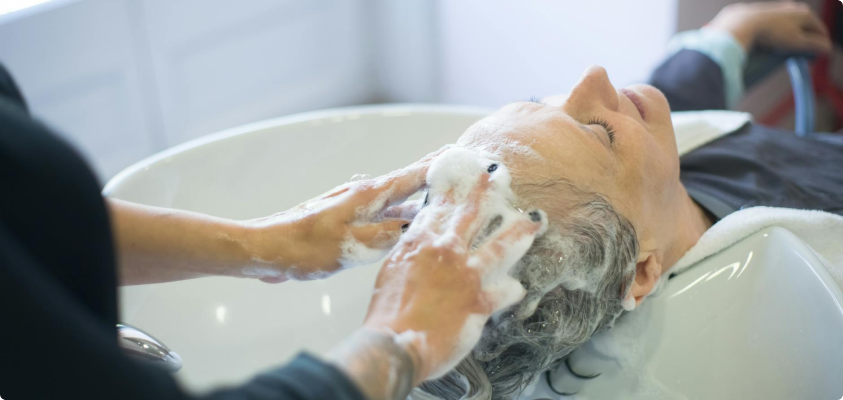1. Choose the Right Shade
Selecting the right color is the foundation for achieving the best results.
- Stay Within Two Shades of Your Natural Color: If it’s your first time dyeing at home, choose a color within two shades lighter or darker than your current hair color for a more natural outcome.
- Consider Your Skin Tone: Cool skin tones look great with ashy, cool shades (like platinum or cool browns), while warm skin tones are better complemented by warm shades (like golden blondes, caramel browns, or copper reds).
- Test with Temporary Color: If you’re unsure about your chosen shade, start with a semi-permanent or temporary dye to test the color before committing to something permanent.
2. Gather the Right Tools
Having the right tools ensures smooth application and even results.
- Hair Color Kit: Most box dyes come with everything you need, but some may lack extras like gloves or a brush.
- Wide-Tooth Comb: To detangle your hair and ensure even distribution of the dye.
- Hair Clips: For sectioning your hair into manageable parts.
- Old Towel or Cape: To protect your clothes from stains.
- Vaseline: Apply along your hairline, ears, and neck to prevent dye from staining your skin.
- Gloves: Ensure you wear gloves to avoid staining your hands.
3. Prepare Your Hair
Prepping your hair properly before dyeing ensures the color adheres well and looks even.
- Start with Dirty Hair: Natural oils help protect your scalp from irritation, so don’t wash your hair right before coloring. Ideally, dye hair that hasn’t been washed for a day or two.
- Detangle and Section: Comb through your hair to remove any tangles, then divide it into four sections using hair clips. This helps you apply the dye more evenly.
4. Do a Patch Test
Before diving into the full application, perform a patch test to check for allergic reactions.
- Mix a Small Amount of Dye: Apply a bit of the mixed dye behind your ear or on your wrist and leave it for 24 hours.
- Check for Reactions: If there’s no itching, redness, or irritation, it’s safe to proceed with the full dyeing process.
5. Apply the Hair Color
Follow these steps for even, flawless application.
- Read the Instructions Carefully: Every dye kit is different, so make sure you understand the timing and application process specific to the product you’re using.
- Start at the Roots: Your roots will need the longest time to process, so begin applying the dye there first. Use the nozzle or a brush to carefully saturate your roots, working through the sections of your hair.
- Work Through to the Ends: After your roots are covered, move on to the rest of your hair. Use your gloved hands or a comb to ensure the dye is evenly distributed.
- Set a Timer: Follow the recommended time on the instructions. Leaving the dye in for too long can result in an over-processed or uneven color.
6. Rinse and Condition
After the processing time, it’s important to rinse the dye properly to lock in the color.
- Rinse with Cool Water: Once your time is up, rinse your hair with cool water until the water runs clear. Avoid hot water, as it can strip the color and cause dryness.
- Use the Conditioner Provided: Most hair color kits come with a post-color conditioner that helps lock in moisture and shine. Apply it generously, focusing on the ends of your hair.
7. Care for Your New Hair Color

To keep your hair color vibrant and healthy, proper aftercare is key.
- Use Sulfate-Free Shampoo: Sulfates can strip your hair of its color, so switch to a color-safe or sulfate-free shampoo to maintain vibrancy.
- Limit Heat Styling: Heat can fade hair color faster. When you do use heat styling tools, always apply a heat protectant.
- Deep Condition Weekly: Colored hair needs extra hydration, so incorporate a deep conditioning treatment into your routine once a week to keep your hair soft and shiny.
- Avoid Over-Washing: The more often you wash your hair, the quicker your color will fade. Try to extend the time between washes using dry shampoo when necessary.
8. Touching Up Roots
After a few weeks, your roots will start to show, but you can easily touch them up at home.
- Use a Root Touch-Up Kit: These kits are specifically designed for easy application to small areas, like your roots.
- Blend the Color: After applying the dye to your roots, use your comb to blend the new color into the existing shade for a seamless look.
9. Common Mistakes to Avoid
After a few weeks, your roots will start to show, but you can easily touch them up at home.
- Not Enough Dye: If you have thick or long hair, one box may not be enough. Buy an extra box to ensure you have enough dye to fully saturate your hair.
- Skipping the Strand Test: Always test a small strand of hair to ensure the color will look right on your hair type and texture.
- Leaving Dye on Too Long: Stick to the timing recommended in the instructions to avoid over-processing, which can lead to damage or uneven color.
10. When to Seek Professional Help
While at-home hair coloring is a great option for many, certain situations are best left to professionals.
- Drastic Color Changes: Going from dark brown to platinum blonde, for example, is risky without a pro’s help. Drastic changes require special techniques to avoid damage.
- Correcting a Bad Color Job: If a DIY color job goes wrong, don’t try to fix it yourself. A professional colorist can help you correct the issue safely.
Conclusion
With the right preparation, tools, and care, achieving perfect hair color at home is possible and rewarding. Take your time, follow the steps carefully, and enjoy the stunning results!
